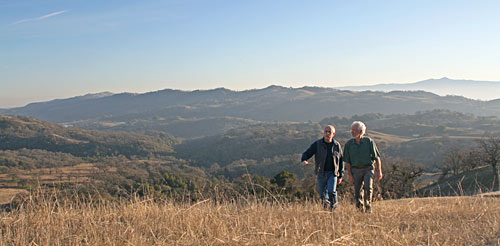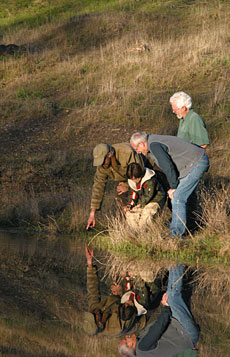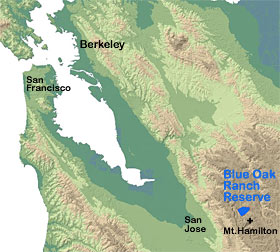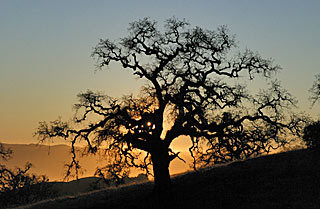 Berkeley biologist Todd Dawson (left) and reserve director Mike Hamilton hike through Blue Oak Ranch Reserve, with a vista of the Mount Hamilton Range spread out behind them. (Robert Sanders/UC Berkeley photo) |
UC Berkeley Press Release
Campus to manage new oak woodland reserve near San Jose
BERKELEY – At a time when California's cherished oak woodlands are in danger of lapsing into senility, a new University of California reserve will support research to discover why these trees are failing to thrive or regenerate.
Integrative biology professor Todd Dawson tells about the possibilities for research and community outreach at Blue Oak Ranch Reserve.
(2:06 min.) Watch larger video
Jeff Wilcox, the steward of Blue Oak Ranch Reserve, tells about what has been accomplished at the ranch to try to restore it to it's natural state.
(1:14 min.) Watch larger video
Mike Hamilton, Blue Oak Ranch Reserve director, on his vision for a one-of-a-kind, completely sustainable "eco-station" where scientists can conduct research on the reserve.
(0:58 min.) Watch larger video
Videos produced by Roxanne Makasdjian/ Media RelationsManaged by UC Berkeley, the reserve is home to mature, gnarled blue oaks, valley oaks and two species of live oak, not to mention endangered California tiger salamanders, Foothill yellow-legged frogs, native trout and river otters. It is the newest of 36 California reserves overseen by the 10-campus UC system's Natural Reserve System for research and education.
Donated anonymously to the University of California in December 2007 and valued at about $5 million, the land borders Joseph D. Grant County Park on the south. The reserve's rolling, tree-studded hills and valleys are only an hour's drive from UC Berkeley and UC Santa Cruz, making it the only UC reserve accessible for day trips by Bay Area K-12 schools as well as by college students.
"Blue Oak Ranch Reserve is an important addition to the UC family of reserves, providing something not found in many places," said the reserve's faculty director, Todd Dawson, UC Berkeley professor of integrative biology. "Both an oak woodland and an urban-wildland interface, this reserve will be able to draw in UC faculty, UC students and the broader community, who will come to appreciate what a wonderful place it is for research and education."
Embedded within 180,000 acres of permanently protected wild lands and open space in the Mount Hamilton Range, Blue Oak Ranch Reserve is protected by a conservation easement held by The Nature Conservancy. The site, with only a barn and no electricity, is now being improved to provide facilities for researchers and college students and, eventually, school groups and the general public.
"This is completely raw land that has been essentially undeveloped for its entire history," said reserve director Michael Hamilton. "We have a clean slate on which to design an ecologically sustainable field station where we capture and produce all of our own electrical energy through solar photovoltaic modules, heat and cool the air and water in our buildings using passive and active solar systems, and develop sustainable water and waste management systems. Such a comprehensive design approach has never been done at a biological field station anywhere in the world, and we are poised to implement our plan thanks to the extraordinary expertise on the UC Berkeley campus."
Hamilton envisions green dormitories, classrooms, laboratories and offices designed by UC Berkeley environmental design and engineering faculty and students to surpass the highest "green" building standards. The construction will be made possible by a generous start-up grant for the reserve, as well as from support and an endowment that accompanied the land transfer. The reserve is eligible to apply for additional funds through state funding allocated by Proposition 84, approved by voters in 2006.
 From left: Jeff Wilcox (reserve steward). Todd Dawson (faculty director), and Mike Hamilton (reserve director) show a young visitor the eggs of endangered tiger salamanders. (Jerry Booth/UC Natural Reserve System photo) |
This information will be piped to the outside world via a high-speed Internet link through UC Lick Observatory atop Mt. Hamilton, which is within sight of portions of the reserve, said Hamilton, an internationally-recognized expert in using technology to further environmental science. Hamilton formerly directed the UC James Reserve in Southern California's San Jacinto Mountains, where he and his colleagues outfitted the landscape with hundreds of wireless sensors and instruments.
"These sensors work much like cell phones that can talk to a network and bring that data back to scientists and students interested in how the landscape is working," said Dawson, who has installed sensors in coast redwoods and at UC's Angelo Coast Range Reserve.
One problem biologists hope to address is the decline of our state's oak woodlands.
"We are not getting new seedlings in the oak woodlands and oak-savanna ecosystems, which means that ultimately we are losing oaks from California," said Dawson. "Blue Oak Ranch Reserve provides an excellent opportunity for starting investigations to find out why the oaks are not regenerating and why the woodlands are declining throughout the state. We have a lot of oak species here. That problem could be worked on from many points of view."
 Because the reserve is as an important connection for migratory wildlife in the long corridor running through Alameda and Santa Clara counties, it also provides opportunities for major research projects that address large-scale conservation and land management issues of regional, state and national concern. The reserve supports more than 430 species of plants, 130 of birds, 41 of mammals, seven of amphibians, 14 of reptiles, seven of fish, and hundreds of species of invertebrates.
Because the reserve is as an important connection for migratory wildlife in the long corridor running through Alameda and Santa Clara counties, it also provides opportunities for major research projects that address large-scale conservation and land management issues of regional, state and national concern. The reserve supports more than 430 species of plants, 130 of birds, 41 of mammals, seven of amphibians, 14 of reptiles, seven of fish, and hundreds of species of invertebrates.
The reserve's location near a fast-growing urban area also makes it ideal for studying issues like nitrogen deposition and loss of biodiversity that are particularly acute in the urban-wildland interface.
Also making the reserve an important research tool is the fact that, despite more than 100 years of cattle grazing, it has moved closer to its original state through 10 years of work by ranch manager Jeff Wilcox, now the reserve's steward. Wilcox has eradicated many invasive species, including bullfrogs, non-native fish and, thanks to a 10-mile perimeter fence, feral pigs. He has also achieved some measure of control for fennel, broom, yellow star thistle, hemlock and non-native grasses.
 One of the reserve's signature oaks glows with the light of the setting sun. (Jerry Booth/UC Natural Reserve System photo) |
"I feel like I have the best job in the world," Wilcox said. "Each day I walk into 3,300 acres of pristine landscape. But it needs to be looked at by a wide range of people with a wide range of interests."
"What Blue Oak Ranch Reserve provides for the urban community is access to a beautiful oak woodland and oak-savanna ecosystem that has been preserved so that people can come and see natural ecological processes and appreciate this very important part of what California is," Dawson said.

